Abstract
In July 2019, the European Commission asked EFSA to provide a statement on the available outcomes of the human health assessment in the context of the pesticides peer review for the renewal of approval of the active substance chlorpyrifos conducted in accordance with Commission Implementing Regulation (EC) No 844/2012. The current statement contains a summary of the main findings of the assessment related to human health following the pesticides peer review expert discussions in mammalian toxicology held between 1 and 5 April 2019, as well as EFSA's additional considerations, including whether the active substance can be expected to meet the approval criteria applicable to human health as laid down in Article 4 of Regulation (EC) No 1107/2009. The identified concerns are presented as follows.
Keywords: chlorpyrifos, pesticide, insecticide, peer review, human health assessment
Short abstract
This publication is linked to the following EFSA Journal article: http://onlinelibrary.wiley.com/doi/10.2903/j.efsa.2019.5810/full
Summary
Chlorpyrifos is an active substance covered by the third batch of the renewal programme for pesticides (‘AIR3’) in accordance with Commission Implementing Regulation (EU) No 844/2012.
Applications (June 2013) and supplementary dossiers (July 2015) for the renewal of approval of the active substance chlorpyrifos were submitted by a Task Force (comprising of Dow AgroSciences and Adama Agriculture B.V.) and by Sapec Agro SA.
An initial evaluation of the dossiers was provided by the rapporteur Member State (RMS) Spain in the Renewal Assessment Report (RAR) which was submitted to European Food Safety Authority (EFSA) in July 2017. Subsequently, EFSA initiated a peer review of the pesticides risk assessment on the RMS evaluation in line with the provisions of Commission Implementing Regulation (EU) No 844/2012.
The commenting period was completed and included a public consultation on the RAR. Following evaluation of the comments received as well as the additional information provided by the applicants in response to a request in accordance with Article 13(3) of Regulation (EU) No 844/2012, a meeting of experts from EFSA and Member States, including relevant experts from the EFSA Panel on Plant Protection Products and their Residues (PPR Panel), took place to discuss certain elements related to mammalian toxicology.
In July 2019, prior to completion of the full peer review process, EFSA was mandated by the European Commission to provide a statement on the available outcomes of the human health assessment in the context of the peer review of chlorpyrifos.
The present statement contains a summary of the main findings of the assessment related to mammalian toxicology and human health following the Pesticides Peer Review Expert discussions in mammalian toxicology held between 1 and 5 April 2019. It also comprises EFSA's additional considerations, including whether the active substance can be expected to meet the approval criteria which are applicable to human health as laid down in Article 4 of Regulation (EC) No 1107/2009.
Due to the fact that the genotoxic potential of chlorpyrifos remains unclear, toxicological reference values could not be established. Moreover, significant uncertainties were linked to the neurodevelopmental toxicity study, where effects were observed at the lowest dose tested in rats (decrease in cerebellum height corrected by brain weight). These concerns were supported by the available epidemiological evidence related to developmental neurological outcomes in children. In the absence of toxicological reference values, a risk assessment for consumers, operators, workers, bystanders and residents cannot be conducted. This issue represents a critical area of concern for chlorpyrifos.
In addition, the recorded toxicological effects meet the criteria for classification as toxic for reproduction category 1B (regarding developmental toxicity).
Based on the above results, it is considered that the approval criteria which are applicable to human health as laid down in Article 4 of Regulation (EC) No 1107/2009 are not met.
1. Introduction
Chlorpyrifos is an active substance covered by the third batch of the renewal programme for pesticides (‘AIR3’) in accordance with Commission Implementing Regulation (EU) No 844/20121.
Applications (June 2013) and supplementary dossiers (July 2015) for the renewal of approval of the active substance chlorpyrifos were submitted by a Task Force (comprising of Dow AgroSciences and Adama Agriculture B.V.) and by Sapec Agro SA. The rapporteur Member State (RMS) is Spain and the co‐rapporteur Member State (co‐RMS) is Poland.
An initial evaluation of the dossiers was provided by the RMS in the Renewal Assessment Report (RAR) which was submitted to EFSA on 3 July 2017 (Spain, 2017). On 18 October 2017, EFSA initiated a peer review of the pesticides risk assessment on the RMS evaluation, by dispatching the RAR to the Member States and applicants for consultation and comments in line with the provisions of Commission Implementing Regulation (EU) No 844/2012. In addition, a public consultation was also conducted.
After the completion of the commenting period, and following a comment evaluation phase, on 4 July 2018 EFSA requested the applicants to provide certain additional information related to all areas of the assessment including mammalian toxicology in accordance with Article 13(3) of Regulation (EU) No 844/2012 which was evaluated by the RMS and presented in an updated RAR (Spain, 2019). Subsequently, in April 2019 a meeting of experts from EFSA and Member States including relevant experts from the EFSA PPR Panel took place to discuss certain elements related to mammalian toxicology.
By means of the mandate received on 1 July 2019 from the European Commission, prior to completion of the full peer review process, EFSA was requested to provide a statement with an overview of the available outcomes of the human health assessment in the context of the peer review of chlorpyrifos.
The present document is an EFSA statement containing a summary of the outcome of the expert consultation outlining the main findings of the assessment related to mammalian toxicology and human health following the pesticides peer review expert discussions in mammalian toxicology held in April 2019, including EFSA's additional considerations and an indication whether the active substance can be expected to meet the approval criteria which are applicable to human health as laid down in Article 4 of Regulation (EC) No 1107/20092.
The list of endpoints for the active substance and the representative formulations assessed in the context of the peer review with regard to the impact on human health is available in Appendix A.
1.1. Background and Terms of Reference as provided by the requestor
On 1 July 2019 EFSA was mandated by the European Commission to provide a statement with an overview of the available outcomes of the human health assessment in the context of the pesticides peer review for the renewal of approval of the active substance chlorpyrifos conducted in accordance with Commission Implementing Regulation (EU) No 844/2012.
In addition, EFSA was requested to indicate, whether the active substance chlorpyrifos can be expected to meet the approval criteria which are applicable to human health as laid down in Article 4 of Regulation (EC) No 1107/2009.
2. Assessment
2.1. Mammalian toxicity
The toxicological profile of the active substance chlorpyrifos was discussed at the Pesticides Peer Review Experts’ Meeting 01 in April 2019 and assessed based on the following guidance documents: SANCO/10597/2003‐rev. 10.1 (European Commission, 2012), Guidance on dermal absorption (EFSA PPR Panel, 2012), ECHA/EFSA Guidance for the identification of endocrine disruptors (EDs) (ECHA and EFSA, 2018) and Guidance on the application of the classification, labelling and packaging (CLP) Criteria (ECHA, 2017).
Regarding the technical specifications of the substance placed on the market by of the three applicants, they are not supported by the toxicological assessment since the level of most impurities contained in the batches was not tested at adequate levels. However, regarding the toxicological relevance of the impurities, considering the toxicological profile including the high acute toxicity and the genotoxic potential of chlorpyrifos, it is not expected that the impurities present in the technical specification would have the potential to add additional hazard established for the parent. One impurity (sulfotep) has been considered as toxicologically relevant by the European Commission (European Commission, 2012). Its relevance is likely based upon the fact that it has a lower oral LD50 value than chlorpyrifos; no toxicological concern is identified for this impurity up to its specified limit in the technical specifications of 3 g/kg. The analytical methods used in the toxicological studies were not available for most of the toxicological studies, representing a concern in particular for the genotoxicity assessment (based on regulatory studies) but not for the critical findings which were retrieved from the published literature (such as the Columbia Center for Children's Environmental Health (CCCEH) study).
In rats, chlorpyrifos is extensively absorbed after oral administration, it is widely distributed, moderately to extensively metabolised by oxidation and hydrolysis and eliminated mostly through urine within 48 h. An in vitro metabolism study indicates that liver microsomes from human, mouse and rat more readily produce a detoxication product (i.e. 3,5,6‐trichloro‐2‐pyridinol – TCP) than an activation product (i.e. chlorpyrifos‐oxon – CPO) and the formation of TCP has been estimated to exceed the formation of chlorpyrifos‐oxon by a factor of 3. A data gap for the determination of the toxicokinetic values for chlorpyrifos (Tmax, Cmax, t1/2, AUC) was identified.
In the acute toxicity studies, chlorpyrifos showed high, moderate and low acute toxicity when administered by the oral, dermal and inhalation routes, respectively, meeting, in the view of the peer review experts, the classification criteria as Acute Tox. 3, H301 ‘Toxic if swallowed’ and Acute Tox. 4, H312 ‘Harmful in contact with skin’ according to the CLP criteria. It is noted that harmonised classification establishes only Acute Tox. 3, H301 according to Annex VI of Regulation (EC) No 1272/20083 regarding human health. The substance did not elicit a potential for skin or eye irritation, skin sensitisation or phototoxicity.
The main effect following short‐ to long‐term repeated oral administration of chlorpyrifos was the inhibition of acetylcholinesterase (AChE) activity, which, at high‐dose levels, was leading to endogenous cholinergic overstimulation resulting in typical cholinergic symptoms. Erythrocyte (RBC) AChE inhibition was the critical effect in all studies. The relevant no observed adverse effect level (NOAEL) was 0.1 mg/kg body weight (bw) per day for both short‐term and long‐term exposure based on a significant decrease of RBC AChE activity at 1 mg /kg bw per day in a 90‐day and 2‐year rat study supported by a 2‐year study in dogs. No evidence for a carcinogenicity potential was found upon chlorpyrifos administration in rats or mice.
No information has been provided on the immunotoxic potential of chlorpyrifos; therefore, a data gap was identified.
2.2. Genotoxicity
During the Pesticides Peer Review 01 Experts’ meeting, the experts discussed the in vitro and in vivo regulatory studies provided in the RAR:
gene mutation: the experts considered that the results from the six bacterial and the three mammalian gene mutations assays overall showed that chlorpyrifos does not induce gene mutations in vitro.
chromosome aberration: chlorpyrifos was also considered not capable to induce chromosome aberration in vitro. Four studies were submitted: although three of them had some methodological limitations and therefore considered acceptable with reservations (one of these three studies produced positive findings), the fourth one was considered fully acceptable and provided negative results.
unscheduled DNA synthesis: six in vitro studies were submitted out of which two produced positive results; the two positive studies were considered acceptable as additional information and were retrieved from a well‐documented publication (Cui et al., 2011).
in vivo studies in somatic cells (mouse bone marrow micronucleus test): the five studies available in the dossiers and evaluated in the RAR, although presenting some methodological limitations, consistently showed negative findings.
The RMS proposed to the applicant to conduct a new in vivo Comet assay (according to OECD Test Guideline 489, OECD, 2014) with batches representative of the current production, in order to clarify the positive findings observed in vitro in one of the chromosome aberration tests and in two studies on unscheduled DNA synthesis. The applicants did not conduct and submit the new study during the renewal procedure. In addition, the experts noted that several publications are available for chlorpyrifos (some of them included in the RAR) which report chromosomal aberrations in vivo (Abdelaziz et al., 2010) and DNA damage in Comet assays both in vitro and in vivo (Mehta et al., 2008; Cui et al., 2011; Sandhu et al., 2013; Kopjara et al., 2018). Although some of these publications present deficiencies as highlighted in the RAR, all the experts agreed that the concerns observed in the public literature studies cannot be ignored and that a genotoxic potential for chlorpyrifos cannot be ruled out. EFSA notes that other organophosphates (OPs) have been reported to cause DNA damage: chlorpyrifos and fenthion have been reported to induce oxidative stress resulting in tissue damage and nuclear DNA damage; diazinon has been shown to cause immediate and direct inhibitory actions on DNA synthesis (Adler et al., 2006). Chlorpyrifos, methyl parathion and malathion have been reported to induce oxidative stress which, in turn, causes damage to all vital macromolecules including lipids, proteins and DNA: oxidative DNA damage can be followed by DNA single and double strand breaks; also, oxidative species may also interact with biological molecules to disrupt normal DNA synthesis and repair. Both acute and chronic exposure with chlorpyrifos, methyl parathion and malathion caused significantly marked DNA damage in rat tissues, namely liver, brain, kidney and spleen, when measured 24 h post treatment (Ojha et al., 2013).
It was also noted that chlorpyrifos can produce DNA damage through topoisomerase II inhibition, as reported in one study using human foetal liver haematopoietic stem cells (Lu et al., 2015), which was mentioned in the EFSA Scientific Opinion on the ‘Investigation into experimental toxicological properties of plant protection products having a potential link to Parkinson's disease and childhood leukaemia’ (EFSA PPR Panel, 2017), but not evaluated in the RAR. Topoisomerase II inhibition is a mechanism likely to have a threshold (EFSA Scientific Committee, 2011); in addition, topoisomerase II inhibition may be involved as a molecular initiating event (MIE) for infant leukaemia (EFSA PPR Panel, 2017). All the experts agreed that a new Comet assay study might not be able to cover this concern. Some experts also pointed out that epidemiological studies showed an important association between pesticides exposure and childhood leukaemia, including infant leukaemia (Ntzani et al., 2013; Hernández and Menéndez, 2016). It was noted that it is not possible to measure endpoints relevant for childhood leukaemia in current OECD standard Test Guidelines, due to higher sensitivity of haematopoietic stem and progenitor cells (HSPCs) compared to the standard cells, and the lack of exposure during the critical period (EFSA PPR Panel, 2017). This could be covered (in terms of exposure window, developmental period) by the extended one generation OECD 443 Test Guideline study (OECD, 2018), but the study is not designed for carcinogenicity assessment. Some experts indicated that this concern may be assessed by using a chromosome aberration study in HSPCs (because these cells have different sensitivity) by using the appropriate window of exposure. All the experts supported the RMS view on the need for additional data to address the concerns regarding chromosome aberration and DNA damage. However, they were not in a position to propose a specific study that could clarify all the above‐mentioned issues (chromosome aberration, DNA damage caused by oxidative stress or through topoisomerase II inhibition, infant leukaemia) and all the experts agreed that these uncertainties should be considered in the risk assessment.
2.3. Reproductive/developmental toxicity and endocrine disruption
In a two‐generation reproductive toxicity study in rats, chlorpyrifos did not affect the reproductive performance up to the highest dose of 5 mg/kg bw per day tested, while RBC AChE inhibition was the critical effect related to parental toxicity with a NOAEL of 0.1 mg/kg bw per day; in this study, reduced pup growth and viability was observed with a NOAEL of 1 mg/kg bw per day. Developmental toxicity was investigated in rats, rabbits and mice. Rats were the most sensitive species in these studies. In rats, erythrocyte AChE inhibition was the critical effect identified regarding maternal toxicity, while increased post‐implantation loss was seen at the highest dose tested. Decreased foetal size and increased post‐implantation loss were observed in rabbits at maternal toxic doses (based on reduced body weight gain). No developmental toxicity potential was observed in mice.
The experts agreed that chlorpyrifos is not an ED in humans, because, in line with other ED assessments recently conducted by EFSA and the guidance for the identification of EDs in the context of Regulation (EU) No 1107/2009 (ECHA and EFSA, 2018), an ED assessment is not scientifically necessary for chlorpyrifos. In all the studies conducted with chlorpyrifos, the NOAEL, the lowest observable adverse effect level (LOAEL) and the maximum tolerated dose (MTD) were based on erythrocyte AChE inhibition and clinical signs at high doses. The overall dose–response pattern for cholinergic overstimulation indicates that chlorpyrifos is a potent AChE inhibitor, and this is practically limiting the possibility of exploring additional target organs/systems.
2.4. Developmental neurotoxicity (DNT)
During the Pesticides Peer Review 01 Experts’ meeting in April 2019, Member State experts and two experts from EFSA's Panel on Plant Protection Products and their Residues (PPR Panel) discussed the available data regarding developmental neurotoxicity (DNT) of chlorpyrifos. They took into consideration and discussed in details: (a) an unpublished study in rats, 1998 (Spain, 2019); (b) public literature presented in the systematic review provided by the applicants; (c) additional literature provided by the experts or during the commenting period.
In the DNT study in rats (1998) (Spain, 2019), pregnant rats were exposed to different levels of chlorpyrifos (0.3, 1 and 5 mg/kg bw per day) from day 6 of gestation until postnatal day (PND) 11. This study was performed according to the United States Environmental Protection Agency (US EPA) guideline OPPTS 870.6300 (US EPA, 1998) and presented some limitations according to the EPA guideline, as well as deviations from the current OECD 426 guideline (OECD, 2007) (lack of findings in the positive control, too short exposure period – from gestational day 6 to lactation day 11 instead of 21 –, lower number of individuals for neuropathology and for learning and memory, behavioural ontogeny, etc); however, the majority of experts agreed that the DNT effects observed in this study were relevant for the risk assessment. The results of the study indicated a decrease in body weight, food consumption and cholinergic toxicity in the dams at the highest dose level. In addition, a statistically significant dose‐related decrease in plasma cholinesterase (ChE) and RBC AChE activities was observed in all treated groups; brain AChE activity was decreased at mid‐ and high‐dose only. According to the contract laboratory, the relevant findings in pups (motor activity changes, decrease in body weight, etc.) were observed at the high‐dose level only. The RMS proposed a maternal LOAEL at 0.3 mg/kg bw per day, based on the inhibition of plasma ChE and RBC AChE, while a pup DNT NOAEL at 1 mg/kg bw per day, based on the decrease in body weight, body weight gain and food consumption, decrease in the viability index, decrease in the absolute brain weight and increase in the relative brain weight observed at 5 mg/kg bw per day.
The US EPA reviewed the same study in 2000 (US EPA, 2000) and concluded that: (1) there were adverse treatment related effects at 1.0 mg/kg bw per day (decrease in the measurement of the parietal cortex, supported by possible, although not significant, alterations in the hippocampal gyrus) in the brain of females at PND 66 and (2) a NOAEL could not be determined due to lack of morphometric data for low dose (0.3 mg/kg bw per day) and a LOAEL for the study was set by the US EPA at 0.3 mg/kg bw per day.
During the discussion of the findings of the DNT study during the peer review experts’ meeting, particular attention was given to the re‐evaluation of the study provided by Mie et al. (2018). Mie expressed each brain regional measure relative to brain weight in order to properly demonstrate the absence of a sensitive target region: a statistically significant decrease in the cerebellum height corrected by brain weight was present in both sexes in the pups at 0.3 and 1 mg/kg bw per day. The absence of a statistically significant effect at high dose can be explained because the decrease of cerebellum height is paralleled with a significant decrease in brain weight (observed at the high‐dose only).
It is well known that morphometry of brain regions is a valuable data for regulatory authorities (Tsuji and Crofton, 2012): the decrease in cerebellum height corrected by brain weight was considered an adverse effect indicating a damage of the architecture of the developing brain (in 2014, the PPR Panel considered the relevance of morphometric analyses as endpoint for hazard characterisation4). The structural changes in the developing rat brain found in regulatory studies are consistent with human data. In particular, children with high prenatal exposure to chlorpyrifos showed frontal and parietal cortical thinning (Rauh et al., 2012). During the peer review meeting, all the experts, but one, agreed to set the LOAEL of the study at 0.3 mg/kg bw per day (for both maternal and pup toxicity). The experts also considered that the reduction of cerebellum height corrected by brain weight could not be explained by the level of AChE inhibition at 0.3 and 1 mg/kg bw per day and this could be related to the difference in sensitivities to AChE inhibition in pups vs. adult rats: foetuses are less exposed than dams and have a high rate of resynthesis of foetal AChE that can result in less net inhibition of foetal AChE (Mattsson et al., 2000). The absence of the effect at high dose was considered related to the high maternal toxicity observed at the dose level tested.
The experts discussed other in vivo, in vitro evidence available from the public literature and the assessment performed in 2016 by the US EPA (US EPA, 2016). They also discussed the potential key events (KEs) of mode of action (MoA)/adverse outcome pathways (AOPs) for these DNT effects: several publications indicate potential MIEs or KEs for DNT of chlorpyrifos and chlorpyrifos‐oxon (e.g. inhibition of fatty acid amide hydroxylase (FAAH), decrease in calcium/calmodulin‐dependent protein kinase type II (CaMKII), interference with tubulin polymerisation and axonal growth, axonal transport, etc.). The experts concluded that AOPs and MIEs for DNT cannot be described at this stage.
The experts discussed the epidemiological evidence showing associations between chlorpyrifos exposure during neurodevelopment and adverse health effects (attention deficit/hyperactivity disorders, decrease in intelligent quotient and working memory, etc). In particular, three main birth cohort studies were considered: the Columbia Center for Children's Environmental Health (CCCEH) study (US EPA, 2016), the Center for the Health Assessment of Mothers and Children of Salinas (CHAMACOS) (Castorina et al., 2010; Marks et al., 2010) and Mt. Sinai study (Sebe et al., 2005). Using different biomarkers of exposure, these studies show that prenatal exposure to OPs produces a consistent pattern of early cognitive and behavioural deficits (Rauh et al., 2012). The experts discussed also other epidemiological evidence from the public literature. The majority of the experts considered that the results from some of these studies (mainly from CCCEH study, Engel et al., 2011; Rauh et al., 2012; Silver et al., 2017) contribute to the evidence of DNT effects in humans due to the exposure to chlorpyrifos and chlorpyrifos‐methyl and occurring at doses lower than that causing 20% inhibition of AChE. Overall, separate lines of evidence indicate that chlorpyrifos and other OPs may affect a variety of neuronal targets and processes that are not directly related to AChE. Therefore, this would represent an additional concern to be taken into consideration for the risk assessment. In addition, it should be noted that in the CHAMACOS study measurement of trichloro‐pyridinol (TCP) in urine5 , common metabolite of both chlorpyrifos and chlorpyrifos‐methyl, contributed to the evidence of DNT effects in humans and exposure to chlorpyrifos and chlorpyrifos‐methyl.
Taking into consideration the DNT study outcome (reduction in cerebellum height – that could not be explained by the maternal AChE inhibition), the epidemiological evidence showing an association between chlorpyrifos exposure during development and neurodevelopmental outcomes, and the overall analysis of the published literature (in vivo, in vitro and human data), the experts suggested6 that the classification of chlorpyrifos as toxic for the reproduction, REPRO 1B, H360D ‘May damage the unborn child’ in accordance with the criteria set out in Regulation (EC) No 1272/2008 would be appropriate.
3. Conclusions
During the Pesticides Peer Review 01 Experts’ meeting in April 2019, all the experts, except one, agreed that the Point of Departure (PoD) for chlorpyrifos should be the DNT LOAEL of 0.3 mg/kg. With regard to the uncertainty factors, the experts went through the overall assessment and concluded that:
the genotoxicity potential remains unclarified (positive findings from an in vitro chromosome aberration study and two in vitro unscheduled DNA synthesis assays; in vivo positive findings from open literature on chromosome aberration and on DNA damage caused through oxidative stress or by topoisomerase II inhibition which was considered a MIE for infant leukaemia);
the effects recorded in the DNT study (decrease in cerebellum height corrected by brain weight already at the lowest dose tested, which is a relevant endpoint for hazard characterisation) indicate a concern;
the epidemiological evidence supports the developmental neurological outcomes in children for chlorpyrifos
Overall, no reference values could in any case be set because of the unclear genotoxicity potential of chlorpyrifos; moreover, significant uncertainties were linked to the neurodevelopmental toxicity study, where effects were observed at the lowest dose tested in rats (decrease in cerebellum height corrected by brain weight). These concerns were supported by the available epidemiological evidence related to developmental neurological outcomes in children. In the absence of toxicological reference values, a risk assessment for consumers, operators, workers, bystanders and residents cannot be conducted. This issue represents a critical area of concern for chlorpyrifos.
In addition, the recorded toxicological effects meet the criteria for classification as toxic for reproduction category 1B (regarding developmental toxicity).
Based on the above, it is considered that the approval criteria which are applicable to human health as laid down in Article 4 of Regulation (EC) No 1107/2009 are not met.
Abbreviations
- AAOEL
acute acceptable operator exposure level
- AChE
acetylcholinesterase
- ADI
acceptable daily intake
- AOEL
acceptable operator exposure level
- AOP
adverse outcome pathway
- ARfD
acute reference dose
- AUC
area under the blood concentration/time curve
- bw
body weight
- CaMKII
calcium/calmodulin‐dependent protein kinase type II
- CCCEH
Columbia Center for Children's Environmental Health
- CHAMACOS
Center for the Health Assessment of Mothers and Children of Salinas
- ChE
cholinesterase
- CLP
classification, labelling and packaging
- Cmax
concentration achieved at peak blood level
- CNS
central nervous system
- co‐RMS
co‐rapporteur Member State
- DNT
developmental neurotoxicity
- ECHA
European Chemicals Agency
- ED
endocrine disruptor
- FAAH
fatty acid amide hydroxylase
- HSPC
haematopoietic stem and progenitor cells
- ICR
Institute of Cancer Research
- KE
key event
- LC50
lethal concentration, median
- LD50
lethal dose, median; dosis letalis media
- LOAEL
lowest observable adverse effect level
- MIE
molecular initiating event
- M&K
Maximization test of Magnussen and Kligman
- MoA
mode of action
- MTD
maximum tolerated dose
- NOAEL
no observed adverse effect level
- OECD
Organisation for Economic Co‐operation and Development
- OP
organophosphate
- PND
postnatal day
- PoD
point of departure
- PPR panel
EFSA's Panel on Plant Protection Products and their Residues
- QSAR
quantitative structure–activity relationship
- RAR
Renewal Assessment Report
- RBC
red blood cells
- RMS
rapporteur Member State
- SD
standard deviation
- t1/2
half‐life (define method of estimation)
- Tmax
time until peak blood levels achieved
- UDS
unscheduled DNA synthesis
- US EPA
United States Environmental Agency
Appendix A – List of endpoints for the active substance and the representative formulations with regard to impact on human health
1.
Impact on Human and Animal Health
Absorption, distribution, metabolism and excretion (toxicokinetics) (Regulation (EU) No 283/2013, Annex Part A, point 5.1)
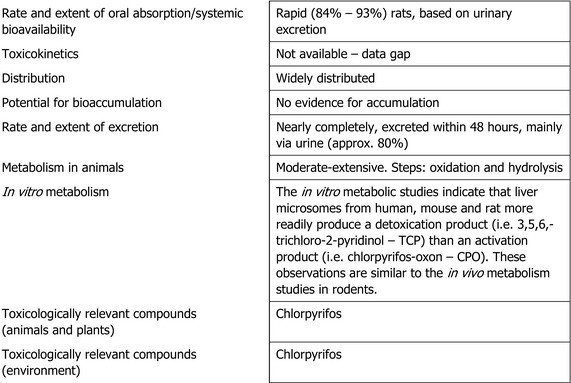
Acute toxicity (Regulation (EU) No 283/2013, Annex Part A, point 5.2)
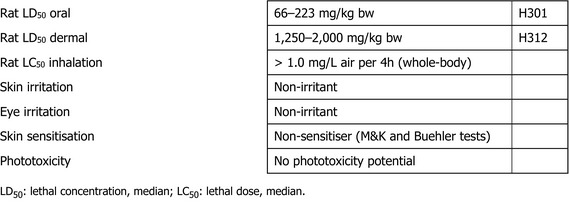
Short‐term toxicity (Regulation (EU) No 283/2013, Annex Part A, point 5.3)
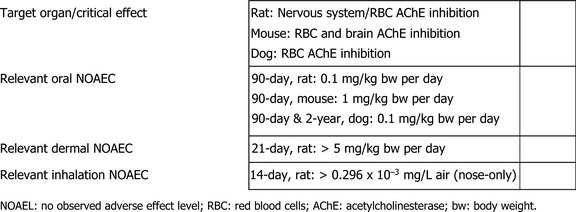
Genotoxicity (Regulation (EU) No 283/2013, Annex Part A, point 5.4)

Long‐term toxicity and carcinogenicity (Regulation (EU) No 283/2013, Annex Part A, point 5.5)
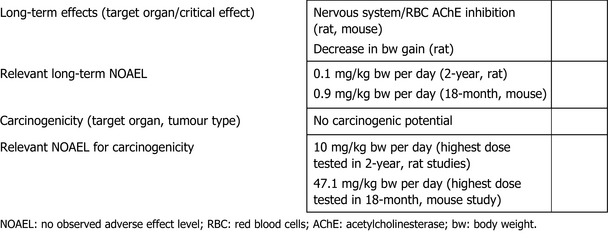
Reproductive toxicity (Regulation (EU) No 283/2013, Annex Part A, point 5.6) Reproduction toxicity
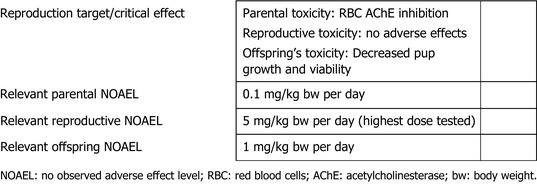
Developmental toxicity
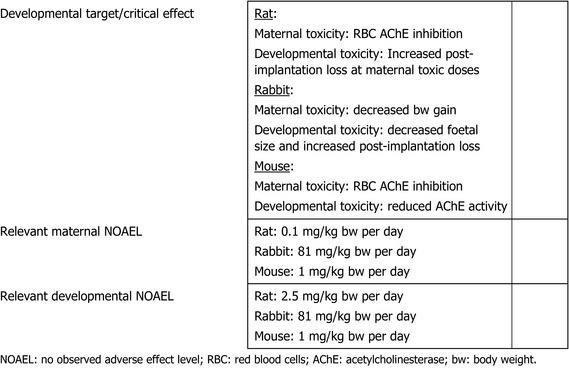
Neurotoxicity (Regulation (EU) No 283/2013, Annex Part A, point 5.7)
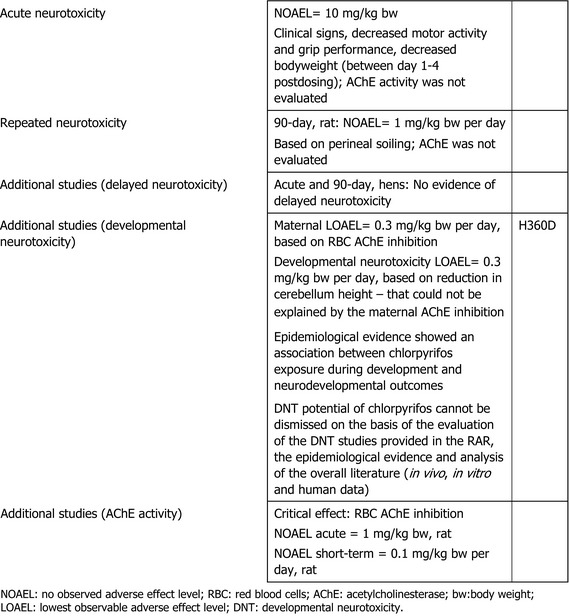
Other toxicological studies (Regulation (EU) No 283/2013, Annex Part A, point 5.8)
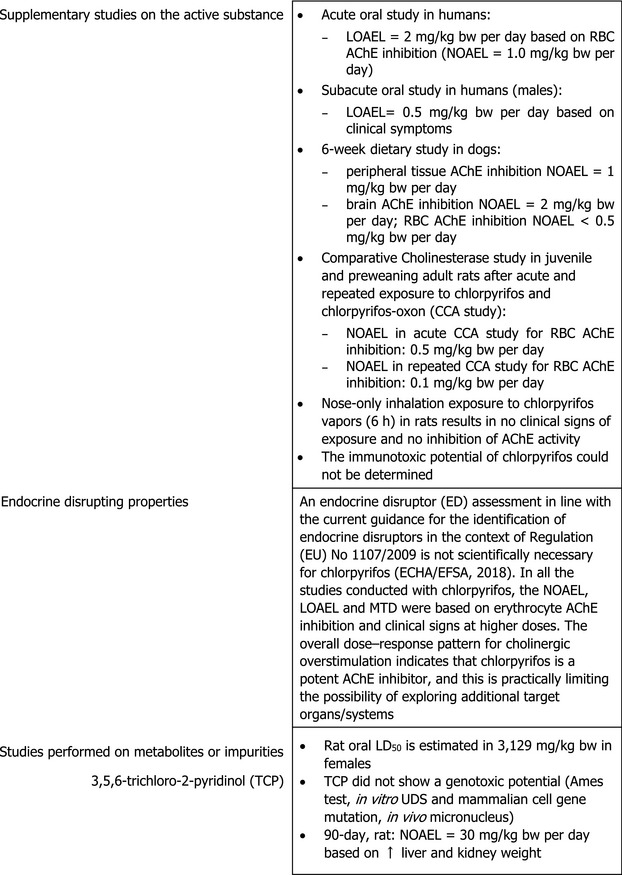
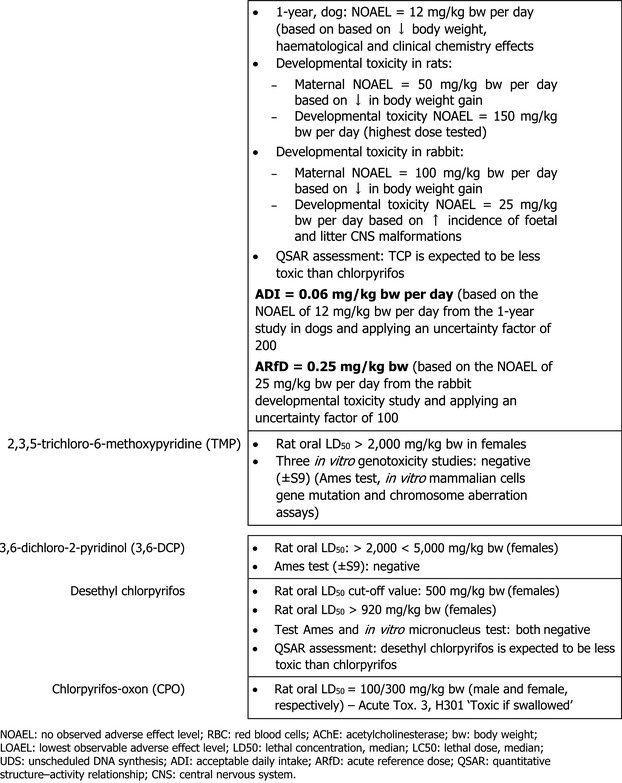
Medical data (Regulation (EU) No 283/2013, Annex Part A, point 5.9)

Summary
7
(Regulation (EU) No 1107/2009, Annex II, point 3.1 and 3.6)
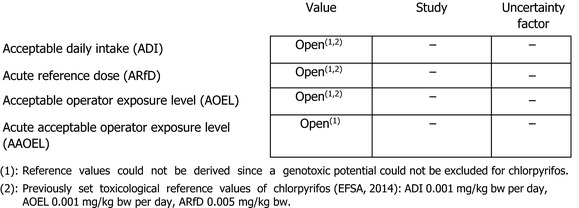
Dermal absorption (Regulation (EU) No 284/2013, Annex Part A, point 7.3)
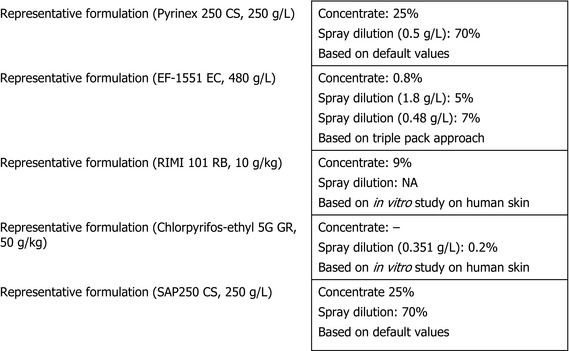
Exposure scenarios (Regulation (EU) No 284/2013, Annex Part A, point 7.2)

Classification with regard to toxicological data (Regulation (EU) No 283/2013, Annex Part A, Section 10)
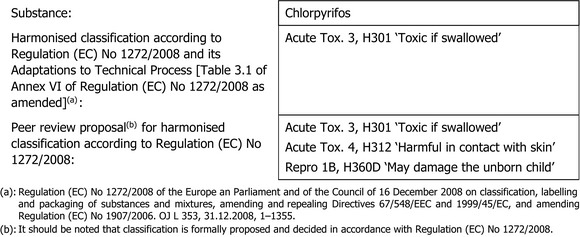
Appendix B – Used compound codes
1.
| Code/trivial name | IUPAC name/SMILES notation/InChIKeya | Structural formulab |
|---|---|---|
| chlorpyrifos |
O,O‐diethyl O‐3,5,6‐trichloro‐2‐pyridyl phosphorothioate Clc1cc(Cl)c(Cl)nc1OP(=S)(OCC)OCC SBPBAQFWLVIOKP‐UHFFFAOYSA‐N |
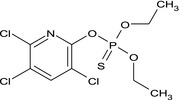
|
| chlorpyrifos‐methyl |
O,O‐dimethyl O‐3,5,6‐trichloro‐2‐pyridyl phosphorothioate Clc1cc(Cl)c(Cl)nc1OP(=S)(OC)OC HRBKVYFZANMGRE‐UHFFFAOYSA‐N |

|
| diazinon |
O,O‐diethyl O‐2‐isopropyl‐6‐methylpyrimidin‐4‐yl phosphorothioate Cc1cc(OP(=S)(OCC)OCC)nc(n1)C(C)C FHIVAFMUCKRCQO‐UHFFFAOYSA‐N |
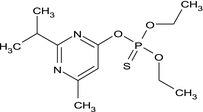
|
| fenthion |
O,O‐dimethyl O‐4‐methylthio‐m‐tolyl phosphorothioate Cc1cc(ccc1SC)OP(=S)(OC)OC PNVJTZOFSHSLTO‐UHFFFAOYSA‐N |

|
| parathion‐methyl |
O,O‐dimethyl O‐4‐nitrophenyl phosphorothioate S=P(Oc1ccc(cc1)[N+]([O‐])=O)(OC)OC RLBIQVVOMOPOHC‐UHFFFAOYSA‐N |

|
| malathion |
S‐1,2‐bis(ethoxycarbonyl)ethyl O,O‐dimethyl phosphorodithioate CCOC(=O)CC(SP(=S)(OC)OC)C(=O)OCC JXSJBGJIGXNWCI‐UHFFFAOYSA‐N |
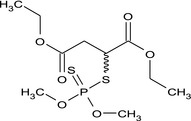
|
| sulfotep |
O,O,O′,O′‐tetraethyl dithiopyrophosphate CCOP(=S)(OCC)OP(=S)(OCC)OCC XIUROWKZWPIAIB‐UHFFFAOYSA‐N |

|
| TCP |
3,5,6‐trichloro‐2‐pyridinol Clc1cc(Cl)c(Cl)nc1O WCYYAQFQZQEUEN‐UHFFFAOYSA‐N |

|
|
chlorpyrifos‐oxon (CPO) |
diethyl 3,5,6‐trichloro‐2‐pyridyl phosphate Clc1cc(Cl)c(Cl)nc1OP(=O)(OCC)OCC OTMOUPHCTWPNSL‐UHFFFAOYSA‐N |

|
| TMP |
2,3,5‐trichloro‐6‐methoxypyridine Clc1cc(Cl)c(Cl)nc1OC RLIVUWLXZBDMBL‐UHFFFAOYSA‐N |

|
| 3,6‐DCP |
3,6‐dichloro‐2‐pyridinol Oc1nc(Cl)ccc1Cl UGPDKBDRRLFGFD‐UHFFFAOYSA‐N |

|
| desethyl chlorpyrifos |
O‐ethyl O‐(3,5,6‐trichloro‐2‐pyridyl) hydrogen (RS)‐phosphorothioate Clc1cc(Cl)c(Cl)nc1OP(O)(=S)OCC WHGNMEMHTPXJRR‐UHFFFAOYSA‐N |

|
ACD/Name 2018.2.2 ACD/Labs 2018 Release (File version N50E41, Build 103230, 21 July 2018).
ACD/ChemSketch 2018.2.2 ACD/Labs 2018 Release (File version C60H41, Build 106041, 07 December 2018).
Suggested citation: EFSA (European Food Safety Authority) , 2019. Statement on the available outcomes of the human health assessment in the context of the pesticides peer review of the active substance chlorpyrifos. EFSA Journal 2019;17(8):5809, 23 pp. 10.2903/j.efsa.2019.5809
Requestor: European Commission
Question number: EFSA‐Q‐2019‐00414
Acknowledgements: EFSA wishes to thank the following for the support provided to this scientific output: Antonio Hernandez and Susanne Hougaard Bennekou.
Approved: 31 July 2019
This publication is linked to the following EFSA Journal article: http://onlinelibrary.wiley.com/doi/10.2903/j.efsa.2019.5810/full
Notes
Commission Implementing Regulation (EU) No 844/2012 of 18 September 2012 setting out the provisions necessary for the implementation of the renewal procedure for active substances, as provided for in Regulation (EC) No 1107/2009 of the European Parliament and of the Council concerning the placing of plant protection products on the market. OJ L 252, 19.9.2012, p. 26.
Regulation (EC) No 1107/2009 of the European Parliament and of the Council of 21 October 2009 concerning the placing of plant protection products on the market and repealing Council Directives 79/117/EEC and 91/414/EEC. OJ L 309, 24.11.2009, p. 1.
Regulation (EC) No 1272/2008 of the European Parliament and of the Council of 16 December 2008 on classification, labelling and packaging of substances and mixtures, amending and repealing Directives 67/548/EEC and 1999/45/EC, and amending Regulation (EC) No 1907/2006. OJ L 353, 31.12.2008, p. 1–1355.
Post‐meeting note: it is also possible that a significant portion of TCP present in urine samples can result from direct intake of TCP preformed in the environment and not as a result of chlorpyrifos or chlorpyrifos‐methyl ingestion (Eaton et al., 2008).
It should be noted that classification is formally proposed and decided in accordance with Regulation (EC) No 1272/2008.
For metabolites, refer to section: Studies performed on metabolites or impurities
References
- Abdelaziz KB, El Makawy AI, El‐Abidin Abd Elsalam AZ and Darwish AM, 2010. Genotoxicity of chlorpyrifos and the antimutagenic role of lettuce leaves in male mice. Communicata Scientiae, 1, 137–145. [Google Scholar]
- Adler M, Aschner M, Bagchi D, Bagchi M, Bakshi KS, Ballantyne B, Baskin SI, Bushnell Us PJ, Chambers JE, Cole TB, Costa LG, De Bleecker JL, Dekundy A, Dettbarn WD, Fonnum F, Fujimoto N, Furlong CE, Garcia SJ, Goodall R, Gordon CJ, Ghosh MC, Gupta PK, Gupta RC, Gurbuz N, Hauschild V, Hilmas CJ, Hosokawa M, Jain AV, Jett DA, King J, Kitamura S, Lein PJ, Lockridge O, Lotti M, Lowit AB, Mack CM, Makris SL, Marrs TC, McCauley LA, Milatovic D, Moffett DB, Moretto A, Mortensen SR, Moser VC, Mulay S, Narahashi T, Opresko D, Padilla S, Pelkonen O, Pope CN, Qian Y, Radic Z, Ray AK, Reiner E, Riviere JE, Rose RL, Rowsey PJ, Salem H, Satoh T, Savolainen K, Schopfer LM, Sharma RP, Sikka SC, Simeon‐Rudolf V, Slotkin TA, Sterri SH, Sugihara K, Umdnj LGS, Syversen T, Tang J, Taylor P, Thorne G, Tiffany‐Castiglioni EC, Timchalk C, Vähäkangas K, Vale JA, Varma DR, Venkatraj V, Viialone A, Watson A, Wild JR, Woltjer RL, Young R, Zafra S and Zoltani CK, 2006. Toxicology of Organophosphate & Carbamate Compounds, Academic Press, Editor(s): Ramesh C. Gupta, 2006. Pages 533–548, ISBN 9780120885237, 10.1016/b978-012088523-7/50000-4 [DOI]
- Castorina R, Bradman A, Fenster L, Barr DB, Bravo R, Vedar MG, Harnly ME, McKone TE, Eisen EA and Eskenazi B, 2010. Comparison of current‐use pesticide and other toxicant urinary metabolite levels among pregnant women in the CHAMACOS cohort and NHANES. Environmental Health Perspectives, 118, 856–863. [DOI] [PMC free article] [PubMed] [Google Scholar]
- Cui Y, Guo J, Xu B and Chen Z, 2011. Genotoxicity of chlorpyrifos and cypermethrin to ICR mouse hepatocytes. Toxicology Mechanisms and Methods, 21, 70–74. [DOI] [PubMed] [Google Scholar]
- Eaton DL, Daroff RB, Autrup H, Bridges J, Buffler P, Costa LG, Coyle J, McKhann G, Mobley WC, Nadel L, Neubert D, Schulte‐Hermann R and Spencer PS, 2008. Review of the toxicology of chlorpyrifos with an emphasis on human exposure and neurodevelopment. Critical Reviews in Toxicology, 38(Suppl 2), 1–125. [DOI] [PubMed] [Google Scholar]
- ECHA (European Chemicals Agency), 2017. Guidance on the Application of the CLP Criteria; Guidance to Regulation (EC) No 1272/2008 on classification, labelling and packaging (CLP) of substances and mixtures. Version 5.0, July 2017. Reference: ECHA‐17‐G‐21‐EN; ISBN: 978‐92‐9020‐050‐5. Available online: https://echa.europa.eu/guidance-documents/guidance-on-clp
- ECHA (European Chemicals Agency) and EFSA (European Food Safety Authority) with the technical support of the Joint Research Centre (JRC), Andersson N, Arena M, Auteri D, Barmaz S, Grignard E, Kienzler A, Lepper P, Lostia AM, Munn S, Parra Morte JM, Pellizzato F, Tarazona J, Terron A and Van der Linden S, 2018. Guidance for the identification of endocrine disruptors in the context of Regulations (EU) No 528/2012 and (EC) No 1107/2009. EFSA Journal 2018;16(6):5311, 135 pp. 10.2903/j.efsa.2018.5311. ECHA‐18‐G‐01‐EN. [DOI] [PMC free article] [PubMed] [Google Scholar]
- EFSA (European Food Safety Authority), 2014. Conclusion on the peer review of the pesticide human health risk assessment of the active substance chlorpyrifos. EFSA Journal 2014;12(4):3640, 34 pp. 10.2903/j.efsa.2014.3640 [DOI] [Google Scholar]
- EFSA PPR Panel (EFSA Panel on Plant Protection Products and their Residues), 2012. Guidance on dermal absorption. EFSA Journal 2012;10(4):2665, 30 pp. 10.2903/j.efsa.2012.2665. [DOI] [Google Scholar]
- EFSA PPR Panel (EFSA Panel on Plant Protection Products and their Residues), Ockleford C, Adriaanse P, Berny P, Brock T, Duquesne S, Grilli S, Hernandez‐Jerez AF, Bennekou SH, Klein M, Kuhl T, Laskowski R, Machera K, Pelkonen O, Pieper S, Smith R, Stemmer M, Sundh I, Teodorovic I, Tiktak A, Topping CJ, Wolterink G, Angeli K, Fritsche E, Hernandez‐Jerez AF, Leist M, Mantovani A, Menendez P, Pelkonen O, Price A, Viviani B, Chiusolo A, Ruffo F, Terron A and Bennekou SH, 2017. Scientific Opinion on the investigation into experimental toxicological properties of plant protection products having a potential link to Parkinson's disease and childhood leukaemia. EFSA Journal 2017; 15(3):4691, 325 pp. 10.2903/j.efsa.2017.4691. [DOI] [PMC free article] [PubMed] [Google Scholar]
- EFSA Scientific Committee , 2011. Scientific Opinion on genotoxicity testing strategies applicable to food and feed safety assessment. EFSA Journal 2011;9(9):2379, 69 pp. 10.2903/j.efsa.2011.2379. Available online: http://www.efsa.europa.eu/efsajournal [DOI] [Google Scholar]
- Engel SM, Wetmur J, Chen J, Zhu C, Barr DB, Canfield RL and Wolff MS, 2011. Prenatal exposure to organophosphates, paraoxonase 1, and cognitive development in childhood. Environmental Health Perspectives, 119, 1182–1188. [DOI] [PMC free article] [PubMed] [Google Scholar]
- European Commission , 2012. Guidance document on the assessment of the equivalence of technical materials of substances regulated under Regulation (EC) No 1107/2009. SANCO/10597/2003‐rev. 10.1, 13 July 2012.
- Hernández AF and Menéndez P, 2016. Linking pesticide exposure with pediatric leukemia: potential underlying mechanisms. International Journal of Molecular Sciences, 17, 461. [DOI] [PMC free article] [PubMed] [Google Scholar]
- Kopjara N, Žunecb S, Mendašc G, Micekd V, Kašubaa V, Mikoliće A, Lovakoviće BT, Milića M, Pavičićf I, Čermakf AMM, Pizente A, Vrdoljakb AL and Želježić D, 2018. Cholinesterase activity, oxidative stress responses, parent compound/metabolite levels, and primary DNA damage in blood and brain tissue of adult male Wistar rats. Chemico‐Biological Interactions, 279, 51–63. [DOI] [PubMed] [Google Scholar]
- Lu C, Liu X, Liu C, Wang J, Li C, Liu Q, Li Y, Li S, Sun S, Yan J and Shao J, 2015. Chlorpyrifos induces MLL translocations through Caspase 3‐dependent genomic instability and topoisomerase II inhibition in human foetal liver haematopoietic stem cells. Toxicological Sciences, 147, 588–606. [DOI] [PubMed] [Google Scholar]
- Marks AR, Harley K, Bradman A, Kogut K, Barr DB, Johnson C, Calderon N and Eskenazi B, 2010. Organophosphate pesticide exposure and attention in young Mexican‐American children: the CHAMACOS study. Environmental Health Perspectives, 118, 1768–1774. [DOI] [PMC free article] [PubMed] [Google Scholar]
- Mattsson JL, Maurissen PJ, Nolan RJ and Brzak KA, 2000. Lack of differential sensitivity to cholinesterase inhibition in Fetuses and neonates compared to dams treated perinatally with chlorpyrifos. Toxicological Sciences, 53, 438–446. [DOI] [PubMed] [Google Scholar]
- Mehta A, Verma RS and Srivastava N, 2008. Chlorpyrifos‐induced DNA damage in rat liver and the brain. Environmental and Molecular Mutagenesis, 49, 426–433. [DOI] [PubMed] [Google Scholar]
- Mie A, Rudén C and Grandjean P, 2018. Safety of safety evaluation of pesticides: developmental neurotoxicity of chlorpyrifos and chlorpyrifos‐methyl. Environmental Health, 17, 77 10.1186/s12940-018-0421-y [DOI] [PMC free article] [PubMed] [Google Scholar]
- Ntzani EE, Chondrogiorgi M, Ntritsos G, Evangelou E and Tzoulaki I, 2013. Literature review on epidemiological studies linking exposure to pesticides and health effects. EFSA Supporting Publication 2013;10(10):EN‐497, 159 pp. 10.2903/sp.efsa.2013.en-497 [DOI] [Google Scholar]
- OECD (Organisation for Economic Co‐operation and Development), 2007. Test No. 426: Developmental Neurotoxicity Study, OECD Guidelines for the Testing of Chemicals, Section 4, OECD Publishing, Paris: 10.1787/9789264067394-en [DOI] [Google Scholar]
- OECD (Organisation for Economic Co‐operation and Development), 2014. Test No. 489: In Vivo Mammalian Alkaline Comet Assay. OECD Publishing, Paris: 10.1787/9789264224179-en [DOI] [Google Scholar]
- OECD (Organisation for Economic Co‐operation and Development), 2018. Test No. 443: Extended One‐Generation Reproductive Toxicity Study, OECD Guidelines for the Testing of Chemicals, Section 4, OECD Publishing, Paris: 10.1787/9789264185371-en [DOI] [Google Scholar]
- Ojha A, Yaduvanshi SK, Pant SC, Lomash V and Srivastava N, 2013. Evaluation of DNA damage and cytotoxicity induced by three commonly used organophosphate pesticides individually and in mixture, in rat tissues. Environmental Toxicology, 28, 543–552. [DOI] [PubMed] [Google Scholar]
- Rauh VA, Perera FP, Horton MK, Whyatt RM, Ravi Bansal R, Hao X, Liu J, Barr DB, Slotkin TA and Peterson BS, 2012. Brain anomalies in children exposed prenatally to a common organophosphate pesticide. PNAS, Proceedings of the National Academy of Sciences of the United States of America, 109, 7871–7876, May 15, 2012. [DOI] [PMC free article] [PubMed] [Google Scholar]
- Sandhu MA, Saeed AA, Khilji MS, Ahmed A, Latif MS and Khalid N, 2013. Genotoxicity evaluation of chlorpyrifos: a gender related approach in regular toxicity testing. The Journal of Toxicological Sciences, 38, 237–244. [DOI] [PubMed] [Google Scholar]
- Sebe A, Satar S, Alpay R, Kozaci N and Hilal A, 2005. Organophosphate poisoning associated with fetal death. Mount Sinai Journal of Medicine, 72, 354–356. [PubMed] [Google Scholar]
- Silver MK, Shao J, Zhu B, Chen M, Xia Y, Kaciroti N, Lozoff B and Meeker JD, 2017. Prenatal naled and chlorpyrifos exposure is associated with deficits in infant motor function in a cohort of Chinese infants. Environment International, 106, 248–256. 10.1016/j.envint.2017.05.015. Epub 2017 Jun 8. [DOI] [PMC free article] [PubMed] [Google Scholar]
- Spain , 2017. Renewal Assessment Report (RAR) on the active substance chlorpyrifos prepared by the rapporteur Member State Spain in the framework of Commission Implementing Regulation (EU) No 844/2012, May 2017. Available online: http://www.efsa.europa.eu
- Spain , 2019. Revised Renewal Assessment Report (RAR) on the active substance chlorpyrifos, volumes relevant for mammalian toxicology, prepared by the rapporteur Member State Spain in the framework of Commission Implementing Regulation (EU) No 844/2012, February 2019.
- Tsuji R and Crofton KM, 2012. Developmental neurotoxicity guideline study: issues with methodology, evaluation and regulation. Congenital Anomalies, 52, 122–128. 10.1111/j.1741-4520.2012.00374.x [DOI] [PubMed] [Google Scholar]
- US EPA (United States Environmental Protection Agency), 1998. The Office of Prevention, Pesticides and Toxic Substances (OPPTS), Health Effects Test Guidelines OPPTS 870.6300 Developmental Neurotoxicity Study, Prevention, Pesticides and Toxic Substances (7101). EPA 712–C–98–239, August 1998.
- US EPA (United States Environmental Protection Agency), 2000. Memorandum of agreement between the Environmental Protection Agency and signatory registrants regarding the registration of pesticide products containing chlorpyrifos. United States Environmental Protection Agency, Washington, DC, June 7, 2000. [Google Scholar]
- US EPA (United States Environmental Protection Agency), 2016. US EPA, Office of Chemical Safety and Pollution prevention. Memorandum on Chlorpyrifos: Revised Human Health Risk Assessment for Registration Review. November 3, 2016.


